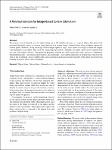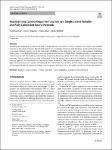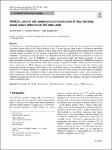Search
Author
- Jorgensen, Ed (3)
- McFadyen, Ron (3)
- Nora, El-Rashidy (3)
- Christian, Homeyer (2)
- next >
Subject
- programming (10)
- Open Access (8)
- Java (7)
- Programming (7)
- next >
Date issued
- 2020 - 2025 (293)
- 2010 - 2019 (39)
- 2000 - 2009 (2)
- 1999 - 1999 (1)
Has File(s)
- true (335)
Search Results
In-situ visual observations of marine organisms is crucial to developing behavioural understandings and their relations to their surrounding ecosystem. Typically, these observations are collected via divers, tags, and remotely-operated or human-piloted vehicles. Recently, however, autonomous underwater vehicles equipped with cameras and embedded computers with GPU capabilities are being developed for a variety of applications, and in particular, can be used to supplement these existing data collection mechanisms where human operation or tags are more difficult. |
We propose a novel minimal solver for sphere fitting via its 2D central projection, i.e., a special ellipse. The input of the presented algorithm consists of contour points detected in a camera image. General ellipse fitting problems require five contour points. However, taking advantage of the isotropic spherical target, three points are enough to define the tangent cone parameters of the sphere. This yields the sought ellipse parameters. Similarly, the sphere center can be estimated from the cone if the radius is known. These proposed geometric methods are rapid, numerically stable, and easy to implement. Experimental results—on synthetic, photorealistic, and real images—showcase the superiority of the proposed solutions to the state-of-the-art methods. A real-world LiDAR-camera c... |
Judgments concerning animals have arisen across a variety of established practice areas. There is, however, no publicly available repository of judgments concerning the emerging practice area of animal protection law. This has hindered the identification of individual animal protection law judgments and comprehension of the scale of animal protection law made by courts. Thus, we detail the creation of an initial animal protection law repository using natural language processing and machine learning techniques. This involved domain expert classification of 500 judgments according to whether or not they were concerned with animal protection law. 400 of these judgments were used to train various models, each of which was used to predict the classification of the remaining 100 judgments... |
The increasing size of deep neural networks (DNNs) raises a high demand for distributed training. An expert could find good hybrid parallelism strategies, but designing suitable strategies is time and labor-consuming. Therefore, automating parallelism strategy generation is crucial and desirable for DNN designers. Some automatic searching approaches have recently been studied to free the experts from the heavy parallel strategy conception. However, these approaches all rely on a numerical cost model, which requires heavy profiling results that lack portability. These profiling-based approaches cannot lighten the strategy generation work due to the non-reusable profiling value. Our intuition is that there is no need to estimate the actual execution time of the distributed training bu... |
Representing Camera Response Function by a Single Latent Variable and Fully Connected Neural Network Modelling the mapping from scene irradiance to image intensity is essential for many computer vision tasks. Such mapping is known as the camera response. Most digital cameras use a nonlinear function to map irradiance, as measured by the sensor to an image intensity used to record the photograph. Modelling of the response is necessary for the nonlinear calibration. In this paper, a new high-performance camera response model that uses a single latent variable and fully connected neural network is proposed. The model is produced using unsupervised learning with an autoencoder on real-world (example) camera responses. Neural architecture searching is then used to find the optimal neural network architecture. A latent distribution learning approach was introduced to constrain the latent... |
In the digital age, the use of advanced technology is becoming a new paradigm in police work, criminal justice, and the penal system. Algorithms promise to predict delinquent behaviour, identify potentially dangerous persons, and support crime investigation. Algorithm-based applications are often deployed in this context, laying the groundwork for a ‘smart criminal justice’. In this qualitative study based on 32 interviews with criminal justice and police officials, we explore the reasons why and extent to which such a smart criminal justice system has already been established in Switzerland, and the benefits perceived by users. Drawing upon this research, we address the spread, application, technical background, institutional implementation, and psychological aspects of the use of ... |
Artificial Intelligence and algorithms are increasingly able to replace human workers in cognitively sophisticated tasks, including ones related to justice. Many governments and international organizations are discussing policies related to the application of algorithmic judges in courts. In this paper, we investigate the public perceptions of algorithmic judges. Across two experiments (N = 1,822), and an internal meta-analysis (N = 3,039), our results show that even though court users acknowledge several advantages of algorithms (i.e., cost and speed), they trust human judges more and have greater intentions to go to the court when a human (vs. an algorithmic) judge adjudicates. |
The mining of time series data has applications in several domains, and in many cases the data are generated by networks, with time series representing paths on such networks. In this work, we consider the scenario in which the dataset, i.e., a collection of time series, is generated by an unknown underlying network, and we study the problem of mining statistically significant paths, which are paths whose number of observed occurrences in the dataset is unexpected given the distribution defined by some features of the underlying network. A major challenge in such a problem is that the underlying network is unknown, and, thus, one cannot directly identify such paths. We then propose CASPITA, an algorithm to mine statistically significant paths in time series data generated by an unkn... |
Contemporary HPC hardware typically provides several levels of parallelism, e.g. multiple nodes, each having multiple cores (possibly with vectorization) and accelerators. Efficiently programming such systems usually requires skills in combining several low-level frameworks such as MPI, OpenMP, and CUDA. This overburdens programmers without substantial parallel programming skills. One way to overcome this problem and to abstract from details of parallel programming is to use algorithmic skeletons. In the present paper, we evaluate the multi-node, multi-CPU and multi-GPU implementation of the most essential skeletons Map, Reduce, and Zip. Our main contribution is a discussion of the efficiency of using multiple parallelization levels and the consideration of which fine-tune settings ... |
In clinical practice, algorithmic predictions may seriously jeopardise patients’ health and thus are required to be validated by medical experts before a final clinical decision is met. Towards that aim, there is need to incorporate explainable artificial intelligence techniques into medical research. In the specific field of epileptic seizure detection there are several machine learning algorithms but less methods on explaining them in an interpretable way. Therefore, we introduce XAI4EEG: an application-aware approach for an explainable and hybrid deep learning-based detection of seizures in multivariate EEG time series. In XAI4EEG, we combine deep learning models and domain knowledge on seizure detection, namely (a) frequency bands, (b) location of EEG leads and (c) temporal char... |









